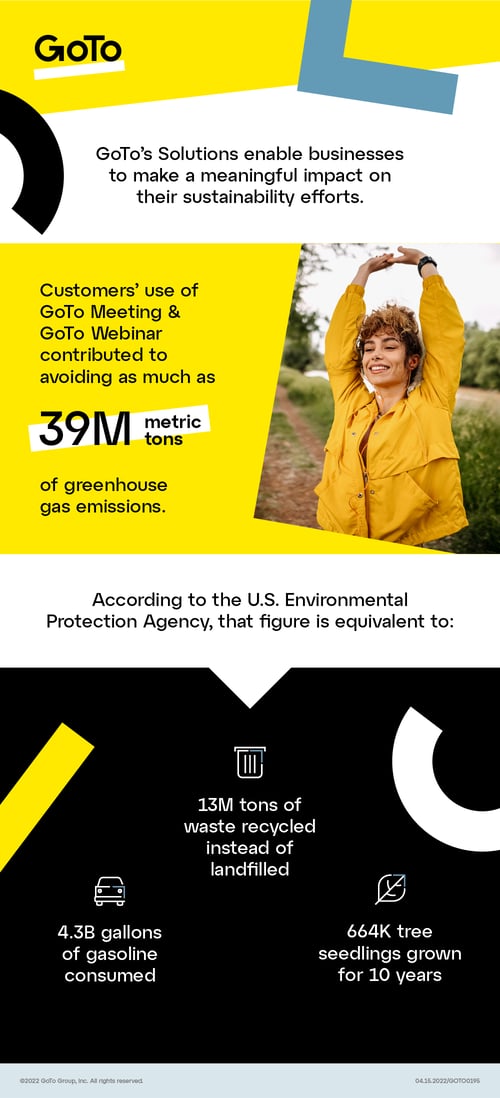In 2020 when the world went remote, the environmental benefits were felt almost overnight, with cleaner air, fewer emissions from travel, and let’s face it, less waste from our favorite daily lunch take outspot.
As many countries continue to come out of various stages of lockdown this year, business is back and so is the office, well, sort of. We will probably never return to the office five days a week, but many are navigating a new hybrid world, ideally one in which employees decide if, or when, to go in.
Despite the fact that some commuting and business travel is back, the numbers are still way down as compared to pre-pandemic levels. In fact, when you look at our GoTo customers, we are proud to have played a role in helping our users avoid as much as an estimated 39 million metric tons* of greenhouse gas emissions in 2021, through the use of products like GoTo Meeting and GoTo Webinar.
That is equivalent to:
- CO2 emissions from 4.3 billion gallons of gasoline consumed OR;
- Carbon removed by 644 million tree seedlings grown for 10 years OR;
- Greenhouse gas emissions avoided by 13 million tons of waste recycled instead of landfilled
These are staggering numbers, and all of us at GoTo are very proud of the impact our products continue to have on the environment, but we also know that impact is not all we should be doing. Research from the Centre for Research into Energy Demand Solutions at the University of Sussex suggests things might not be so cut and dry as turning on the webcam instead of starting up the car.
“While most studies conclude that teleworking can contribute energy savings, the more rigorous studies and those with a broader scope present more ambiguous findings,” the University of Sussex researchers explain. “Where studies include additional impacts, such as non-work travel or office and home energy use, the potential energy savings appear more limited – with some studies suggesting that, in the context of growing distances between the workplace and home, part-week teleworking could lead to a net increase in energy consumption.”
This is why we cannot rely just on remote work to solve the climate crisis – businesses and their employees alike need to take an active role in mitigating personal and home emissions. At GoTo, we’ve added three key initiatives to our overall sustainability program in the last two years. These are tactics that businesses of all sizes can employ to enhance the sustainability of remote and flexible work.
- Offset the estimated emissions of employees working from home: We know that with remote work, employees are spending more time at home and that means electricity, heating, and cooling usage has gone up during the last two years. Think about estimating the consumption of your global employees while at their home offices and offsetting those emissions.
- Encourage green commuting and offset remaining employee commuting emissions with carbon offsets: As you think about returning to the office, consider what that means for your employees and the new commute they will be embarking on that has largely been absent for the last two years. Mitigating travel impact is essential and companies can encourage ride-sharing and commuting by foot or bike. Companies can also estimate employee commutes and procure carbon offsets to cover 1-5 days a week depending on what working style you have adopted.
- Engage with your employees and create Green Teams: Employee engagement can go a long way in achieving sustainability goals and the best way to effect change is to change personal habits. Creating an employee-driven Green Team is a great avenue to do just that. From sharing tips and tricks, holding events for your global employees to flagging corporate initiatives that could be improved, a Green Team is a valuable addition to any company culture.
This April, as we seek to Invest In Our Planet, Earth Month’s 2022 theme, we encourage you to build upon the benefits of remote work. The time is now, and if you are looking for products that make IT easy to help you along your green journey visit GoTo's corporate responsibility page.

* GoTo’s data team derived these figures by summing the distance between all meeting hosts and each participant for all GoTo Meeting and GoTo Webinar sessions for FY21 (excluding audio-only calls, which could reasonably be assumed to replace phone calls, not in-person meetings). The team then assigned each of those distances to different modes of transport using U.S. Federal Highway Administration statistics, to which the team then applied the appropriate U.S. Environmental Protection Agency emissions factor. Equivalencies were derived using the U.S. Environmental Protection Agency’s Greenhouse Gas Equivalencies Calculator.
**According to the U.S. Environmental Protection Agency
